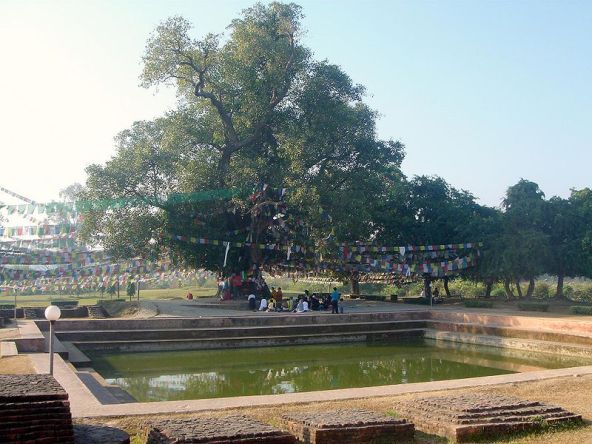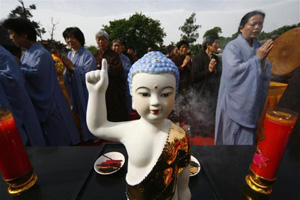China plans to help Nepal develop Buddha’s birthplace at Lumbini

(A reclining Buddha at Wat Po temple in Bangkok April 8,2008/Sukree Sukplang)
A Chinese-backed foundation and Nepal’s government plan to transform Lord Buddha’s birthplace in southern Nepal into a magnet for Buddhists in the same way as Mecca is to Muslims and the Vatican for Catholics. The Asia Pacific Exchange and Cooperation Foundation plans to raise $3 billion at home and abroad to build temples, an airport, a highway, hotels, convention centres and a Buddhist university in the town of Lumbini, about 171 km (107 miles) southwest of Nepal’s capital Kathmandu.
The foundation, blessed by the Chinese government, signed a memorandum of understanding with the Nepalese government last month to jointly develop and operate Lumbini, where Buddha was born Prince Gautama Siddhartha about 2,600 years ago. The foundation also pledged to bring communications, water and electricity to Lumbini.
Buddhism was virtually wiped out in China during the chaotic 1966-76 Cultural Revolution when temples were shut, Buddhist statues smashed, scriptures burned, and monks and nuns forced to return to secular life and marry. In recent years, China has become more tolerant of Buddhism, which is considered “traditional culture” alongside Taoism and Confucianism.

(Bodhi tree and the Mayadevi pond in Lumbini, Nepal, November 2006/Bpilgrim)
“Lumbini will transcend religion, ideology and race. We hope to rejuvenate the spirit of Lord Buddha,” said Xiao Wunan, a devout Buddhist who is executive vice president of the foundation. The development of Lumbini will also help boost government revenues, create jobs and improve infrastructure in the impoverished corner of Nepal, the two sides said in the memorandum. The town attracts nearly 500,000 tourists each year.
Xiao hopes Lumbini can bring together all three schools of Buddhism — the Mahayana, or “Greater Vehicle” which is dominant in China, Hong Kong, Japan, South Korea and Taiwan; Tibetan Buddhism; and the Theravada or Hinayana (“Lesser Vehicle”) which is popular in Cambodia, Myanmar, Sri Lanka and Thailand.
China’s expanding ties with countries in South Asia has stoked concern in giant neighbour India which fears encirclement, but Xiao said there were no political motives behind the push to develop Lumbini. He said that the foundation hoped to talk to New Delhi about the possibility of developing Bodh Gaya in eastern India where Buddha attained enlightenment, and Kushinagar, where he died.

(The Mahabodhi temple compound in the eastern Indian city of Bodh Gaya January 23, 2008/Desmond Boylan)
Hangzhou, capital of China’s eastern coastal province of Zhejiang, hosted the first World Buddhist Forum in 2006, thanks to incumbent Vice President Xi Jinping, then the provincial Party boss who pulled out all the stops to stage the landmark event. The second meeting of the forum was held in Wuxi in nearby Jiangsu province in 2009. China plans to hold the third forum in Xian, home of the terracotta warriors, next year.
Last year, the officially atheist Chinese Communists gave their blessings to Tzu Chi Foundation, a Taiwan Buddhist charity, to set up shop in China, a sign of growing but still limited religious tolerance and as part of a drive to win the hearts and minds of Taiwanese. Tzu Chi opened its China chapter in the form of a bookshop-cum-tea house in Suzhou, Jiangsu province, a popular investment choice for Taiwanese companies which have pumped billions of dollars into the world’s second-biggest economy.

(Buddhist nuns pray in front of a Buddha statue during the annual Phi Ta Khon Festival at a temple in Suining, Sichuan province, China, May 2, 2009/Stringer)
In 2008, Taiwan’s top monk, Hsing Yun, visited China for the first time. China appears set on winning Taiwanese hearts and minds. Hsing Yun is now a best-selling author in China, has met former president Jiang Zemin twice and has been allowed to build a temple in Yixing, Jiangsu province, as well as hold a calligraphy exhibition.
Among further signs of growing tolerance. museums in Beijing and Shanghai hosted exhibits last year to commemorate the 400th anniversary of the death of Matteo Ricci, the Italian Jesuit who brought Christianity to China.
via China plans to help Nepal develop Buddha’s birthplace | Reuters.
(Reclining Buddha statue at Wat Po temple in Bangkok, 26 December 2006/Tom Heneghan)
Back to Top>>
|